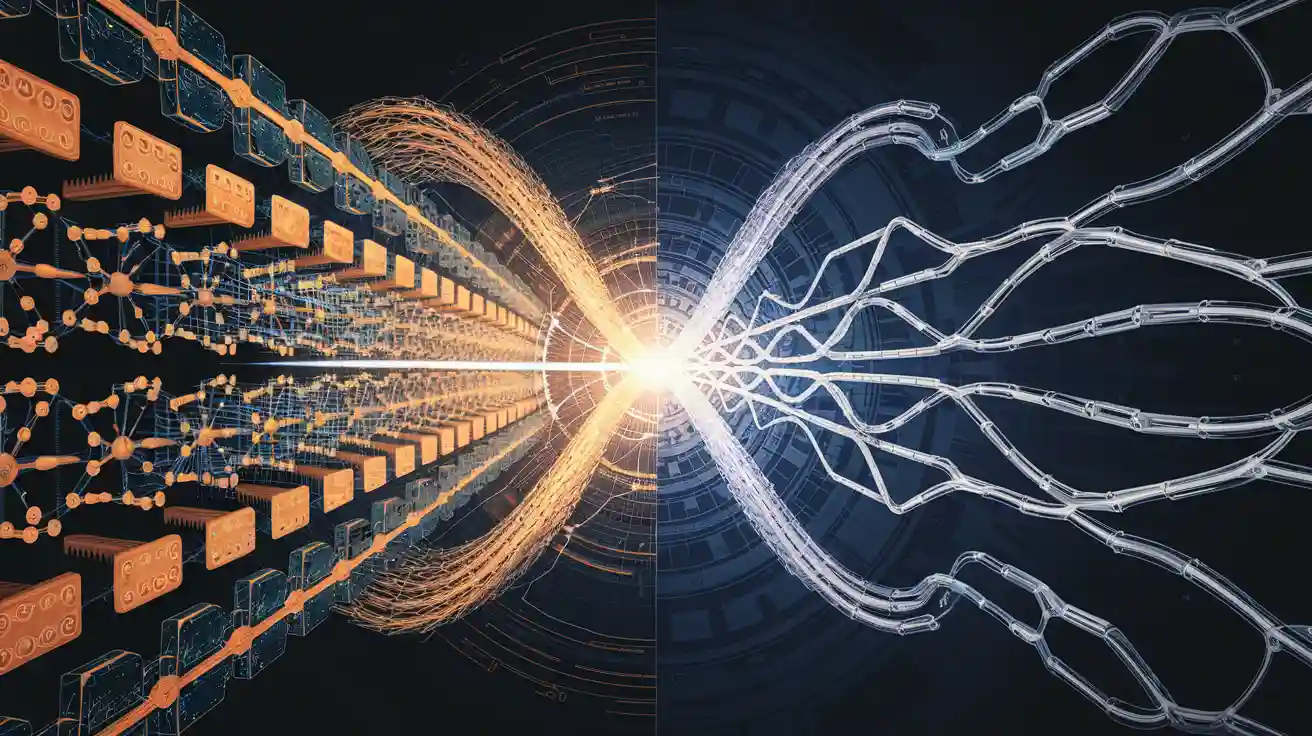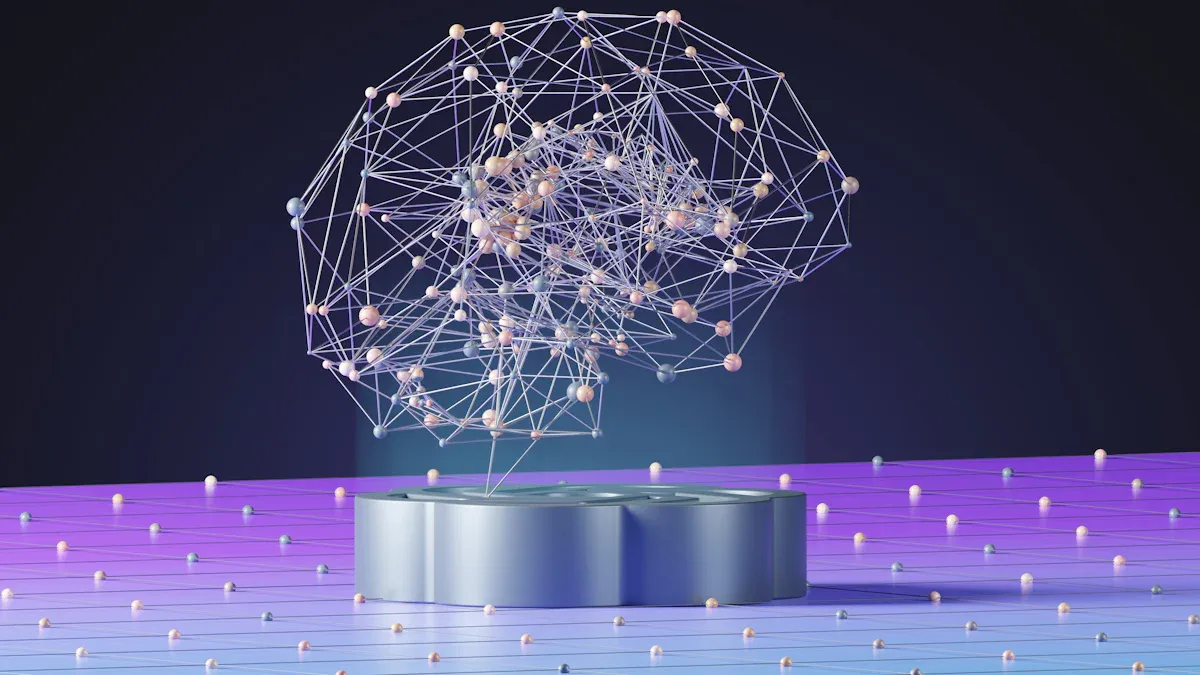
When it comes to AI models, Convolutional Neural Networks (CNNs) and Recurrent Neural Networks (RNNs) stand out for their unique strengths. CNNs excel at analyzing spatial data like images, while RNNs shine with sequential data, such as text or speech. The difference lies in how they process information—CNNs focus on static patterns, and RNNs handle dynamic sequences.
Understanding these distinctions helps you pick the right model for your project. Whether you're working on image recognition or language translation, knowing which network fits your data can save time and boost performance.
Key Takeaways
-
CNNs work well for studying pictures and spatial data. They are great at finding patterns like edges and textures.
-
RNNs are made for data in a sequence, like sentences or sounds. They are perfect for tasks like translating languages or recognizing speech.
-
Use CNNs for fast and efficient projects, especially with big datasets. RNNs are better for understanding how things change over time.
-
Mixing CNNs and RNNs can improve results in tough tasks. This uses the best parts of both models.
-
Always think about your data type and project needs. This helps you pick between CNNs and RNNs for the best outcome.
Convolutional Neural Network Overview

Architecture of CNNs
A Convolutional Neural Network (CNN) is built with layers that work together to analyze and interpret visual data. Think of it as a team where each layer has a specific job. The Convolutional Layer scans your input data, like an image, using filters to detect features such as edges or textures. Next, the Pooling Layer steps in to simplify the data by reducing its size while keeping the important parts intact. This makes the model faster and more efficient. The Activation Layer adds a bit of magic by introducing non-linearity, helping the network understand complex patterns. Finally, the Fully Connected Layer ties everything together, combining features to make predictions or classifications.
Here’s a quick breakdown of the layers:
|
Layer Type |
الوصف |
|---|---|
|
Convolutional Layer |
Processes input data through filters to extract features. |
|
Pooling Layer |
Reduces dimensionality while retaining important features. |
|
Activation Layer |
Applies a non-linear function to introduce non-linearity into the model. |
|
Fully Connected Layer |
Combines features from previous layers to produce the final output. |
How CNNs Process Data
When you feed an image into a Convolutional Neural Network, it doesn’t just look at the picture as a whole. Instead, it breaks it down into smaller pieces and analyzes them one by one. The convolutional layers act like detectives, scanning for patterns like edges, shapes, and colors. Pooling layers then summarize the findings, making the data easier to handle. By the time the data reaches the fully connected layers, the network has a clear understanding of what’s in the image. This step-by-step process allows CNNs to excel at tasks like identifying objects or recognizing faces.
Applications of CNNs in AI
You’ve probably seen CNNs in action without even realizing it. They power facial recognition systems, help doctors analyze medical images, and even assist self-driving cars in navigating roads. In agriculture, CNNs monitor crop health using aerial images, while in retail, they enable visual search engines to recommend products based on photos. Here’s a snapshot of how CNNs are used across different sectors:
|
Sector |
Application Description |
Metrics/Examples |
|---|---|---|
|
Image Recognition |
Detect edges, shapes, and textures, classifying thousands of object categories. |
Models like AlexNet, VGGNet, and ResNet achieve high accuracy in feature extraction. |
|
Medical Imaging |
Detect abnormalities in MRI/X-ray scans and perform segmentation tasks. |
High sensitivity in distinguishing malignant from benign lesions. |
|
Autonomous Driving |
Identify lanes, obstacles, and traffic signs for safe navigation. |
Real-time object detection ensures smooth vehicle operation. |
|
Retail |
Analyze images to recommend fashion items and manage inventory. |
Visual search engines enhance user experience and streamline operations. |
|
الزراعة |
Monitor crop health and detect diseases using drone imagery. |
Applications include yield estimation and pest detection. |
|
Security |
Spot suspicious activities in surveillance systems. |
Real-time analytics improve public safety and enable rapid intervention. |
CNNs have revolutionized artificial intelligence, especially in computer vision. They’re not just limited to images; their flexibility allows them to handle other types of data, making them a versatile tool for AI applications.
Recurrent Neural Network Overview
Architecture of RNNs
Recurrent Neural Networks (RNNs) are designed to handle sequential data, making them different from traditional neural networks. What sets RNNs apart is their ability to “remember” information from previous steps in a sequence. They achieve this through feedback loops, where the output from one step becomes the input for the next. This unique structure allows RNNs to maintain a form of memory, which is crucial for tasks like language modeling or speech recognition.
Here’s a quick look at what makes RNNs tick:
-
Feedback Loops: These loops enable the network to process sequences by retaining context from earlier inputs.
-
Variable Input Lengths: Unlike feedforward networks, RNNs can handle inputs of varying lengths, such as sentences or time-series data.
-
Advanced Variants: Over time, RNNs have evolved into more sophisticated architectures like LSTMs (Long Short-Term Memory) and GRUs (Gated Recurrent Units). These models use gating mechanisms to capture long-term dependencies more effectively.
How RNNs Process Sequential Data
When you feed data into an RNN, it doesn’t just process each input independently. Instead, it considers the context provided by previous inputs. For example, in a sentence, the meaning of a word often depends on the words that came before it. RNNs excel at capturing these relationships.
Imagine you’re typing a message on your phone, and it predicts the next word. That’s an RNN at work! It analyzes the sequence of words you’ve already typed and uses that context to make its prediction. This ability to understand temporal dependencies makes RNNs ideal for tasks involving time-series data, speech, or text.
Applications of RNNs in AI
RNNs have found their way into a wide range of real-world applications. Here are some examples:
-
Predictive Text: RNNs power the autocomplete feature on your phone, making typing faster and easier.
-
Speech Recognition: Voice assistants like Siri and Alexa rely on RNNs to understand spoken commands.
-
Stock Market Predictions: RNNs analyze historical data to forecast stock price trends.
-
Medical Diagnostics: In healthcare, RNNs help detect anomalies in sequential data, such as heart rate patterns or MRI scans.
-
Fraud Detection: By monitoring transaction sequences, RNNs identify suspicious activities in real-time.
From improving customer service bots to generating music, RNNs are transforming industries by unlocking the potential of sequential data. Their ability to “think in context” makes them a powerful tool in AI.
Key Differences Between CNNs and RNNs
When deciding between CNNs and RNNs, understanding their differences can help you make the right choice for your AI project. Let’s break it down into three key areas: how they process data, their architecture, and their use cases.
Data Processing Differences
CNNs and RNNs handle data in completely different ways. CNNs focus on spatial data, like images, by analyzing patterns in fixed-size windows. They’re great at spotting local features, such as edges or textures, and they process all input data simultaneously. This makes them fast and efficient for tasks like image recognition.
RNNs, on the other hand, are built for sequential data. They process one input at a time, considering the context of previous inputs. This sequential approach allows them to capture relationships over time, which is why they excel at tasks like language modeling or time-series forecasting.
Here’s a quick comparison to help you visualize these differences:
|
Feature |
CNNs |
RNNs |
|---|---|---|
|
Architecture |
Convolutional layers for feature extraction and pooling layers. |
Sequential processing of input data to capture dependencies. |
|
Performance |
Excels in identifying local patterns and n-grams. |
Effective in capturing long-range dependencies and context. |
|
Ideal Use Cases |
Text classification tasks like sentiment analysis and topic classification. |
Tasks requiring understanding of global context like machine translation and summarization. |
So, if your data has a spatial structure, like images, CNNs are the way to go. But if you’re working with sequences, like text or audio, RNNs will give you better results.
Architectural Differences
The architecture of CNNs and RNNs reflects their unique strengths. CNNs use convolutional layers to extract features and pooling layers to reduce data size. This structure makes them efficient for processing multidimensional arrays, such as images or word embeddings. They’re also faster to train because they process data in parallel.
RNNs, however, rely on recurrent cells with hidden states. These cells allow the network to retain memory of previous inputs, making them ideal for sequential data. But this comes at a cost. RNNs are slower to train and can struggle with long-range dependencies due to issues like vanishing gradients.
Here’s a side-by-side look at their architectural differences:
|
Feature |
CNNs |
RNNs |
|---|---|---|
|
Architecture |
Convolutional layers with pooling |
Recurrent cells with hidden states |
|
Input Type |
Multidimensional arrays (word embeddings) |
Sequential data (time series) |
|
Strengths |
Good for local dependencies, faster training |
Retains memory of previous inputs |
|
Weaknesses |
Overfits small datasets, less effective for long-range dependencies |
Slower training, prone to vanishing gradients |
|
Ideal Use Cases |
Image processing, local context tasks |
Language modeling, tasks with long-range context |
|
Computational Constraints |
More efficient with fixed-size windows |
More parameters, can overfit |
If you need speed and efficiency, CNNs are a solid choice. But for tasks that require understanding context over time, RNNs are worth the extra effort.
Use Case Differences
The choice between CNNs and RNNs often comes down to the type of problem you’re solving. CNNs dominate in fields like computer vision, where they’re used for image classification, object detection, and video analysis. Their ability to process visual data quickly and accurately makes them indispensable in industries like healthcare, retail, and autonomous driving.
RNNs, on the other hand, shine in tasks involving sequential data. They’re widely used in speech recognition, time-series forecasting, and natural language processing. For example, RNNs power virtual assistants like Siri and Alexa, helping them understand and respond to your commands.
Here’s a quick overview of their use cases:
|
Network Type |
Applications |
Metrics |
|---|---|---|
|
CNN |
Image Classification, Object Detection, Image Segmentation, Video Analysis |
High processing speed, accuracy in visual tasks |
|
RNN |
Speech Recognition, Time-Series Forecasting |
Long-term and short-term dependency handling, effective in sequential data analysis |
In short, CNNs are your go-to for visual tasks, while RNNs are better suited for problems that require understanding sequences or context.
Performance Comparison
When it comes to performance, CNNs and RNNs each have their strengths and weaknesses. Choosing between them depends on what you value most—speed, accuracy, or adaptability. Let’s break it down so you can see how they stack up against each other.
Speed and Efficiency
CNNs are like sprinters. They process data in parallel, making them faster and more efficient for tasks like image recognition. Their architecture allows them to handle large datasets without breaking a sweat. If you’re working on a project that needs quick results, CNNs are your best bet.
RNNs, on the other hand, are more like marathon runners. They process data sequentially, which takes time. This step-by-step approach makes them slower, especially when dealing with long sequences. If your project involves real-time predictions or large-scale data, you might find RNNs a bit sluggish.
Tip: If speed is critical, go for CNNs. RNNs are better suited for tasks where understanding context matters more than speed.
Accuracy
Accuracy is where things get interesting. CNNs excel at tasks that require pinpoint precision in spatial data. For example, they can identify objects in images with incredible accuracy. Their ability to focus on local patterns makes them reliable for visual tasks.
RNNs shine in tasks that involve sequential data. They’re great at capturing relationships over time, which boosts their accuracy in language modeling or time-series forecasting. However, they can struggle with very long sequences due to issues like vanishing gradients.
|
Metric |
CNNs |
RNNs |
|---|---|---|
|
Speed |
High |
Moderate to Low |
|
Accuracy |
Excellent for spatial data |
Excellent for sequential data |
|
Scalability |
Handles large datasets well |
Struggles with long sequences |
Scalability
CNNs scale beautifully. Their parallel processing makes them ideal for handling large datasets, like millions of images. You can train them on powerful GPUs to speed things up even more.
RNNs, however, face challenges with scalability. As sequences get longer, their performance can drop. They require more computational resources and are prone to overfitting if the dataset isn’t diverse enough.
Suitability for Tasks
Here’s the bottom line: CNNs are perfect for tasks that involve spatial data, like images or videos. They’re fast, accurate, and scalable. RNNs are your go-to for sequential data, like text or audio. They’re slower but excel at understanding context and relationships over time.
Note: If your project involves both spatial and sequential data, consider combining CNNs and RNNs for the best of both worlds.
In the end, the choice between CNNs and RNNs boils down to your project’s needs. Think about what matters most—speed, accuracy, or the ability to handle sequences—and pick the model that fits the bill.
Choosing Between CNNs and RNNs
Factors to Consider
Choosing between CNNs and RNNs isn’t always straightforward. It depends on the type of data you’re working with and the problem you’re trying to solve. To make the right choice, you’ll need to weigh several factors.
First, think about the nature of your data. Is it spatial, like images or videos? Or is it sequential, like text, audio, or time-series data? CNNs are fantastic for spatial data because they can learn hierarchical patterns, such as edges, textures, and shapes. On the other hand, RNNs are built to handle sequences where the order of inputs matters.
“CNNs are particularly effective for image-related tasks due to their ability to learn hierarchical representations, while RNNs excel in processing sequential data where the order of inputs is significant.”
Next, consider the complexity of your task. If your project involves understanding relationships over time—like predicting stock prices or translating languages—RNNs are better suited. Their feedback mechanism allows them to “remember” past inputs, which is crucial for capturing temporal dependencies.
“RNNs possess a unique feedback mechanism to maintain an internal memory of past inputs. This ‘memory' enables RNNs to capture temporal dependencies and patterns in data, making them ideal for NLP, time series analysis, and speech recognition.”
However, RNNs aren’t perfect. They can struggle with long-term dependencies due to the vanishing gradient problem, where earlier inputs lose their influence over time. This limitation might affect their performance in tasks requiring a deep understanding of long sequences.
“Recurrent Neural Networks (RNNs) are a subclass of artificial neural networks specifically designed to process sequential data where the order of inputs holds significant meaning. However, RNNs have challenges. They can grapple with the vanishing gradient problem, where the influence of earlier inputs diminishes over time, hindering their ability to capture long-term dependencies.”
Finally, don’t forget about user experience and trust. If your AI system will interact with people, factors like usability, biases, and user-centered design play a big role. For example, automation surprises or inadequate mental models can lead to confusion and distrust.
-
User experience
-
Trust and biases
-
Usability of AI systems
-
User-centered design
By keeping these factors in mind, you’ll be better equipped to choose the right model for your project.
Examples of Suitable Applications
Let’s look at some real-world examples to see where CNNs and RNNs shine.
CNN Applications
CNNs dominate tasks that involve visual data. For instance:
-
Image Classification: Identifying objects in photos, like cats, cars, or buildings.
-
Medical Imaging: Detecting tumors in X-rays or segmenting organs in MRI scans.
-
Autonomous Vehicles: Recognizing traffic signs, pedestrians, and lane markings.
These applications rely on CNNs’ ability to process spatial data quickly and accurately.
RNN Applications
RNNs, on the other hand, excel in tasks involving sequences. Here are a few examples:
-
Speech Recognition: Converting spoken words into text for virtual assistants like Siri.
-
Language Translation: Translating sentences from one language to another.
-
Time-Series Forecasting: Predicting stock prices or weather patterns based on historical data.
These tasks require understanding the order and context of inputs, which is where RNNs shine.
Decision-Making Guidelines
So, how do you decide which model to use? Here are some practical guidelines to help you out:
-
Start with Your Data
Ask yourself: Is my data spatial or sequential? If it’s spatial, like images or videos, go with CNNs. If it’s sequential, like text or time-series data, RNNs are the better choice. -
Consider the Task Requirements
Think about what your project needs. Does it involve understanding relationships over time? RNNs are great for that. Does it require analyzing patterns in static data? CNNs are your best bet. -
Evaluate Performance Needs
If speed and efficiency are critical, CNNs are faster and easier to train. But if accuracy in sequential tasks is more important, RNNs might be worth the extra effort. -
Think About Scalability
CNNs handle large datasets well and scale efficiently. RNNs, however, can struggle with long sequences and require more computational resources. -
Test and Iterate
Sometimes, the best way to decide is to experiment. Train both models on your data and compare their performance. This hands-on approach can give you valuable insights.
By following these guidelines, you’ll be able to make an informed decision that aligns with your project’s goals.
Tip: If your project involves both spatial and sequential data, consider combining CNNs and RNNs for a hybrid approach. This way, you can leverage the strengths of both models.
Combining CNNs and RNNs for Hybrid Applications

Benefits of Combining Models
When you combine CNNs and RNNs, you get the best of both worlds. CNNs excel at extracting spatial features, like patterns in images, while RNNs specialize in understanding sequences, such as time-series data. Together, they create a powerful hybrid model capable of tackling complex tasks.
For example, in medical image classification, hybrid models like CNN-Transformer architectures combine CNNs’ ability to detect local features with Transformers’ knack for capturing global dependencies. This approach not only boosts predictive performance but also provides interpretable results, such as class-specific evidence maps.
|
Feature |
الوصف |
|---|---|
|
Model Type |
|
|
Application |
Medical Image Classification |
|
Strengths |
Combines local feature extraction of CNNs with global dependency capture |
|
Interpretability |
Generates localized evidence maps reflecting decision processes |
|
Performance |
Achieves state-of-the-art predictive performance in a single forward pass |
By leveraging the strengths of both models, hybrid systems can handle unstructured data like images and structured sequences like text, making them versatile for AI applications.
Examples of Hybrid Use Cases
Hybrid models shine in real-world scenarios where both spatial and sequential data are involved. For instance:
-
Radiology Report Analysis: A study showed that combining CNNs and RNNs outperformed traditional models, achieving an AUC of 0.93. These models generalized well across datasets from different institutions, proving their adaptability.
-
Activity Recognition: Models like CNN-BiLSTM achieved over 96% accuracy in classifying similar activities, outperforming simpler architectures.
-
Weather Forecasting: Hybrid CNN-LSTM frameworks effectively predict direct normal irradiance (DNI) by analyzing spatial and temporal dependencies.
|
Model Type |
Accuracy (%) |
F1-Score (%) |
Notes |
|---|---|---|---|
|
CNN-GRU |
> 96 |
N/A |
Performs better than CNN-LSTM. |
|
CNN-BiLSTM |
> 96 |
93.38 |
Superior to CNN-GRU in most cases. |
These examples highlight how hybrid models can tackle diverse challenges, from healthcare to environmental forecasting.
Challenges in Integration
While hybrid models are powerful, they come with their own set of challenges. One major issue is data insufficiency. Training these models requires large datasets, which aren’t always available. For instance, in gene expression studies, researchers often struggle to gather enough data for effective training.
|
Challenge |
الوصف |
|---|---|
|
Data Insufficiency |
Difficulty in obtaining sufficient data for training models effectively. |
|
Overfitting |
Risk of models performing well on training data but poorly on unseen data due to complexity. |
|
Complexity of Data |
Gene expression data presents unique challenges that complicate integration efforts. |
Another challenge is overfitting, where the model performs well on training data but struggles with unseen data. This is especially true for complex hybrid architectures. Additionally, integrating CNNs and RNNs increases computational demands, making training slower and more resource-intensive.
Despite these hurdles, hybrid models remain a promising solution for tasks requiring both spatial and sequential analysis. With careful planning and optimization, you can overcome these challenges and unlock their full potential.
Choosing between CNNs and RNNs boils down to understanding their strengths and matching them to your project’s needs. CNNs excel at analyzing spatial data like images, while RNNs thrive on sequential data such as text or time-series patterns. Knowing these differences helps you make smarter decisions and avoid wasting time on mismatched models.
To pick the right model, follow these steps:
-
Define your problem clearly, including input data and desired output.
-
Analyze your data’s structure, volume, and patterns.
-
Check your computational resources for training and deployment.
-
Match the complexity of your task with the model’s capabilities.
-
Focus on performance metrics that matter for your application.
-
Consider interpretability, especially for critical sectors like healthcare.
-
Explore pre-trained models and transfer learning to save time.
-
Factor in training time and scalability for future growth.
By following these tips, you’ll set yourself up for success in your AI projects. Whether you’re building a facial recognition system or a language translator, the right model makes all the difference.
التعليمات
What’s the main difference between CNNs and RNNs?
CNNs process spatial data like images, focusing on patterns in fixed regions. RNNs handle sequential data, such as text or time-series, by considering the order of inputs. Think of CNNs as analyzing snapshots, while RNNs follow a storyline.
Can CNNs and RNNs work together?
Yes! Combining CNNs and RNNs creates hybrid models. CNNs extract spatial features, while RNNs analyze sequences. For example, in video analysis, CNNs process frames, and RNNs track changes over time. This teamwork boosts performance in complex tasks.
Which is easier to train: CNNs or RNNs?
CNNs are generally faster and easier to train. They process data in parallel, making them efficient. RNNs, however, process inputs sequentially, which takes more time and computational power. If speed matters, CNNs are the better choice.
Are RNNs outdated with the rise of Transformers?
Not at all! While Transformers are powerful, RNNs still excel in specific tasks like real-time predictions or lightweight applications. They’re simpler and require fewer resources, making them a practical choice for many projects.
How do I decide between CNNs and RNNs for my project?
Start with your data. Use CNNs for spatial data like images and RNNs for sequences like text. Consider task complexity, speed, and scalability. If your project involves both data types, try a hybrid approach for the best results.








